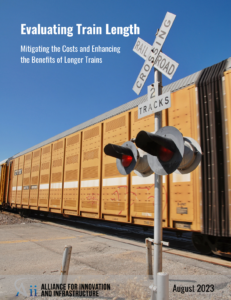Washington, D.C. (August 7, 2023) – The Alliance for Innovation and Infrastructure (Aii) published its latest report Monday, Evaluating Train Length: Mitigating the Costs and Enhancing the Benefits of Longer Trains.
The report evaluates train length amidst a wide-ranging national debate over railroad safety and issues such as crew size and train length which have elevated labor/corporate tensions and political debate. As Congress considers the Railway Safety Act, numerous states consider train length restrictions, and the FRA initiates an information collection action, the new Aii report aims to better equip policymakers with data in hand to implement targeted reforms that will mitigate the costs of longer trains while enhancing the benefits they can provide.
The report assesses train length through three lenses: safety, economic costs and benefits, and environmental impacts. The report finds that there are both costs and benefits to longer trains, but there is no clear correlation between increased train length and safety concerns. Environmentally, it may be that longer trains are more beneficial than the alternative.
The report assesses train length through three lenses: safety, economic costs and benefits, and environmental impacts. The report finds that there are both costs and benefits to longer trains, but there is no clear correlation between increased train length and safety concerns. Environmentally, it may be that longer trains are more beneficial than the alternative.
The safety evaluation includes review of Federal Railroad Administration data on train accidents, crossing incidents, and both public and railroad employee casualties. The analysis was unable to conclude that these categories are correlated with increased risks from longer trains.
Economically, the report finds that longer trains result in higher average cost per incident, while the average cost per train car decreases for train accidents as train length increases. Too little public data is available for a conclusive finding with regard to blocked crossings, but the report cautions that capping train length may simply result in more trains, which could also block crossings.
Finally, environmental impacts are reduced by longer trains. With respect to hazardous material releases, the industry safety record is maintained irrespective of train length, while longer trains offer lower carbon emissions relative to the alternatives of more trains or trucks.
“Despite the popular and negative gut-level reaction to longer trains, the data helps settle certain concerns while offering a lot of angles to consider before making public policy changes,” says author and Aii Executive Director Benjamin Dierker. “There is certainly a reasonable limit to the length a freight train should be, but from accident reporting forms and public data, there is not yet a clear picture of what that length is or how it should be set – whether by a regulatory cap, industry leadership, or collective bargaining.”
###
About the Author
Benjamin Dierker is the Executive Director of Aii, specializing in economic, administrative, and legal aspects of American energy, transportation, infrastructure, and innovation. He is a graduate of Texas A&M University with a bachelor of economics, the Bush School of Government and Public Service with a master of public administration, and the Scalia Law School at George Mason University with a juris doctor.
###
About the Alliance for Innovation and Infrastructure
The Alliance for Innovation and Infrastructure (Aii) is an independent, national research and educational organization dedicated to identifying our nation’s infrastructure needs, creating awareness of those needs, and finding solutions to critical public policy challenges. Aii strives to promote proven, innovative technology and higher safety standards in a non-partisan manner to achieve excellence nationwide. The Alliance is a think tank consisting of two non-profits: the National Infrastructure Safety Foundation (NISF) 501(c)(4) and the Public Institute for Facility Safety (PIFS) 501(c)(3). (Aii.org)
